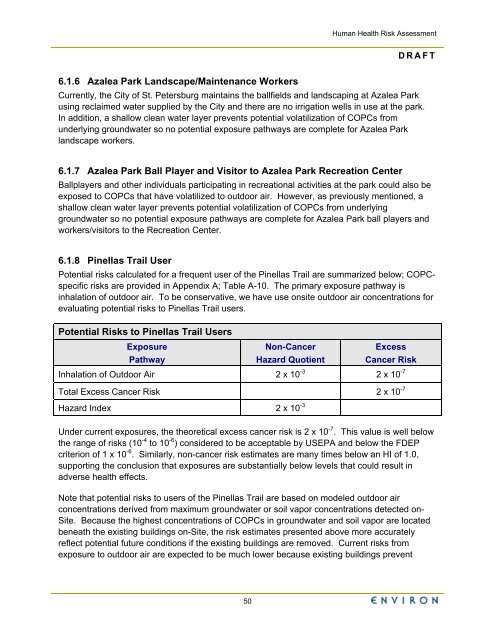Human Health Risk Assessment - Raytheon
Human Health Risk Assessment - Raytheon
Human Health Risk Assessment - Raytheon
You also want an ePaper? Increase the reach of your titles
YUMPU automatically turns print PDFs into web optimized ePapers that Google loves.
6.1.6 Azalea Park Landscape/Maintenance Workers<br />
50<br />
<strong>Human</strong> <strong>Health</strong> <strong>Risk</strong> <strong>Assessment</strong><br />
DRAFT<br />
Currently, the City of St. Petersburg maintains the ballfields and landscaping at Azalea Park<br />
using reclaimed water supplied by the City and there are no irrigation wells in use at the park.<br />
In addition, a shallow clean water layer prevents potential volatilization of COPCs from<br />
underlying groundwater so no potential exposure pathways are complete for Azalea Park<br />
landscape workers.<br />
6.1.7 Azalea Park Ball Player and Visitor to Azalea Park Recreation Center<br />
Ballplayers and other individuals participating in recreational activities at the park could also be<br />
exposed to COPCs that have volatilized to outdoor air. However, as previously mentioned, a<br />
shallow clean water layer prevents potential volatilization of COPCs from underlying<br />
groundwater so no potential exposure pathways are complete for Azalea Park ball players and<br />
workers/visitors to the Recreation Center.<br />
6.1.8 Pinellas Trail User<br />
Potential risks calculated for a frequent user of the Pinellas Trail are summarized below; COPCspecific<br />
risks are provided in Appendix A; Table A-10. The primary exposure pathway is<br />
inhalation of outdoor air. To be conservative, we have use onsite outdoor air concentrations for<br />
evaluating potential risks to Pinellas Trail users.<br />
Potential <strong>Risk</strong>s to Pinellas Trail Users<br />
Exposure<br />
Non-Cancer<br />
Excess<br />
Pathway<br />
Hazard Quotient Cancer <strong>Risk</strong><br />
Inhalation of Outdoor Air 2 x 10 -3 2 x 10 -7<br />
Total Excess Cancer <strong>Risk</strong> 2 x 10 -7<br />
Hazard Index 2 x 10 -3<br />
Under current exposures, the theoretical excess cancer risk is 2 x 10 -7 . This value is well below<br />
the range of risks (10 -4 to 10 -6 ) considered to be acceptable by USEPA and below the FDEP<br />
criterion of 1 x 10 -6 . Similarly, non-cancer risk estimates are many times below an HI of 1.0,<br />
supporting the conclusion that exposures are substantially below levels that could result in<br />
adverse health effects.<br />
Note that potential risks to users of the Pinellas Trail are based on modeled outdoor air<br />
concentrations derived from maximum groundwater or soil vapor concentrations detected on-<br />
Site. Because the highest concentrations of COPCs in groundwater and soil vapor are located<br />
beneath the existing buildings on-Site, the risk estimates presented above more accurately<br />
reflect potential future conditions if the existing buildings are removed. Current risks from<br />
exposure to outdoor air are expected to be much lower because existing buildings prevent

















